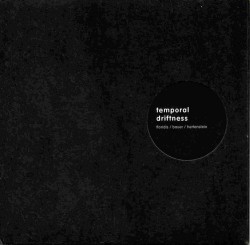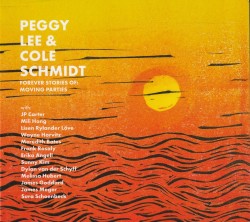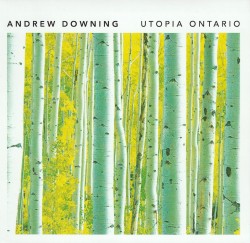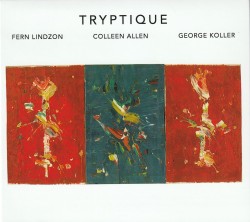A mainstay of so-called classical music since its creation in the 16th century, the cello is prominent in orchestral, string ensemble and solo settings. Innovators like Oscar Pettiford and Fred Katz created roles for the four-string instrument in mainstream jazz during the 1950s, but it was only with free improvisers’ acceptance of new sounds and instruments about 20 years later that cellos became almost as common on bandstands as guitars and double basses. Today while the cello is most often found in small ensembles, numerous musicians are finding new ways to use the instrument.
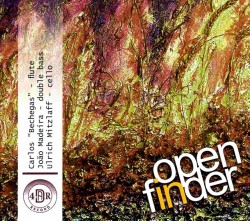 One outfit that presents a variant of improvised chamber music consists of German cellist Ulrich Mitzlaff and two Portuguese, flutist Carlos Bechegas and bassist João Madeira, although the four tracks of Open in Finder (4DaRecord 4DRCD 009 joaomadeira.bandcamp.com/album/open-in-finder) are anything but standard concert hall fare. Complementing the bassist’s thick pizzicato throbs and woody arco strains and the flutist’s transverse trills and peeps, Mitzlaff’s timbres slide between the extremes. At points his connection is with Madeira as he doubles the woody sul ponticello emphasis. Elsewhere his kaleidoscopic angling extends the flutist’s turn towards refinement, mating mid-range cello slices with Bechegas’ aviary flutters. Nowhere is the disc background music though. The flutist’s range encompasses circular-breathed whines and shallow stop time, and for every segue into linear advancement there are interludes where the strings’ strategy is both staccato and spiccato. On the extended Drag After Two for instance, Bechegas mines unexpected metallic tones from inside his instrument as the string players extend the line at a speedy pace while working up and down the scale. Sequences are unexpectedly cut off or extended and during the introductory Stream for One percussive and prestissimo horizontal movement is interrupted by one player vocally yodelling, scatting and mumbling rhythmically before a jab on the strings below the cello’s bridge wraps up the track.
One outfit that presents a variant of improvised chamber music consists of German cellist Ulrich Mitzlaff and two Portuguese, flutist Carlos Bechegas and bassist João Madeira, although the four tracks of Open in Finder (4DaRecord 4DRCD 009 joaomadeira.bandcamp.com/album/open-in-finder) are anything but standard concert hall fare. Complementing the bassist’s thick pizzicato throbs and woody arco strains and the flutist’s transverse trills and peeps, Mitzlaff’s timbres slide between the extremes. At points his connection is with Madeira as he doubles the woody sul ponticello emphasis. Elsewhere his kaleidoscopic angling extends the flutist’s turn towards refinement, mating mid-range cello slices with Bechegas’ aviary flutters. Nowhere is the disc background music though. The flutist’s range encompasses circular-breathed whines and shallow stop time, and for every segue into linear advancement there are interludes where the strings’ strategy is both staccato and spiccato. On the extended Drag After Two for instance, Bechegas mines unexpected metallic tones from inside his instrument as the string players extend the line at a speedy pace while working up and down the scale. Sequences are unexpectedly cut off or extended and during the introductory Stream for One percussive and prestissimo horizontal movement is interrupted by one player vocally yodelling, scatting and mumbling rhythmically before a jab on the strings below the cello’s bridge wraps up the track.
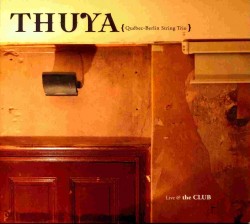 Another trio, but with a more conventional chamber music line up is the Quebec-Berlin String Trio. On Thuya: Live @ the Club (Creative Sources CS 378 CD creativesources.bandcamp.com/album/live-the-club), Germans, violinist Gerhard Uebele and bassist Klaus Kürvers plus Québecois cellist Remy Belanger de Beauport perform two multi-part instant compositions recorded at the same place but a half year apart. Throughout both dates de Beauport too plays the mediator’s role, creating thick double stops and mid-range slides that knit together Uebele’s frequent squeaky sul ponticello stings and Kürvers’ buzzing string stops. With the three players unleashing scrapes, plinks and squeaks as often as intertwined glissandi, May 6 is the climax of the first set. Working up to prestissimo with prods from the bows’ frogs as well as a pinched interface, apogee is reached as elevated violin tones arch over the undulating lower strings with an interlude of swelling hoedown-like phrasing from the cellist. More aggressive and confident six months previously, November’s track doubles down on the trio’s cohesion at the same time as raucous fiddler screeches frequently interrupt linear evolution. Although this is quickly countered with warm drones from the lower pitched strings. Again before completing the sequences with layered rubs from all, the penultimate November 10 finds this mid-range interlude alternating fragmenting and connecting as the trio members swop sweetened sul tasto affiliations with wood-rending strains and stops from the bassist, string bounces from the violinist and biting mandolin-like strokes from the cellist.
Another trio, but with a more conventional chamber music line up is the Quebec-Berlin String Trio. On Thuya: Live @ the Club (Creative Sources CS 378 CD creativesources.bandcamp.com/album/live-the-club), Germans, violinist Gerhard Uebele and bassist Klaus Kürvers plus Québecois cellist Remy Belanger de Beauport perform two multi-part instant compositions recorded at the same place but a half year apart. Throughout both dates de Beauport too plays the mediator’s role, creating thick double stops and mid-range slides that knit together Uebele’s frequent squeaky sul ponticello stings and Kürvers’ buzzing string stops. With the three players unleashing scrapes, plinks and squeaks as often as intertwined glissandi, May 6 is the climax of the first set. Working up to prestissimo with prods from the bows’ frogs as well as a pinched interface, apogee is reached as elevated violin tones arch over the undulating lower strings with an interlude of swelling hoedown-like phrasing from the cellist. More aggressive and confident six months previously, November’s track doubles down on the trio’s cohesion at the same time as raucous fiddler screeches frequently interrupt linear evolution. Although this is quickly countered with warm drones from the lower pitched strings. Again before completing the sequences with layered rubs from all, the penultimate November 10 finds this mid-range interlude alternating fragmenting and connecting as the trio members swop sweetened sul tasto affiliations with wood-rending strains and stops from the bassist, string bounces from the violinist and biting mandolin-like strokes from the cellist.
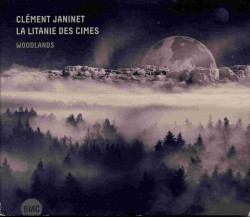 A more expanded identity for the cello is expressed by Bruno Ducret during the ten tracks that make up Woodlands (BMC CD 314 bmcrecords.hu/en/albums/la-litanie-des-cimes-woodlands), One third of violinist Clément Janinet’s all French La Litanie des Cimes – clarinetist Elodie Pasquier is the other member – the group’s blend of folkloric melodies, reiterated minimalist pulses and the rock music-like thrusts wrapped in creative improvisation, has Ducret replicating the sounds of a double bass, a 12-string guitar or percussion at various points. Janinet’s super spiccato string stabs are also splayed to resemble tones that could come from a Medieval vielle, a Bluegrass fiddle or the most contemporary electrified four-string instrument. Pasquier who mostly sticks to clarion emphasis usually provides the linear stasis. With thumps midway between those of a doumbek and a conga drum the cellist become a percussionist on Shadows for example as the violinist exuberantly piles notes upon notes from his string set until a sudden stop when he and the cellist suddenly appear to be playing guitars. It takes broken-chord reed snorts to wrap up the track. Alternately on Quiet Waltz – which is neither quiet nor a waltz – the cello snakes around stops and slides and replicates walking bass plucks as soaring violin glissandi frame the clarinet’s andante horizontal line. Narrowly missing screech timbres at points, Pasquier’s most notable expression is on With The New (Tribute To Bina Koumaré) where her evolution from simple flutters to precise double tonguing presents a contrapuntal challenge to Janinet’s ecstatic strokes which vibrate at twice the speed of her output in this tribute to the West African fiddle master. Eventually it takes Ducret’s double bass emulation to steady the disparate parts.
A more expanded identity for the cello is expressed by Bruno Ducret during the ten tracks that make up Woodlands (BMC CD 314 bmcrecords.hu/en/albums/la-litanie-des-cimes-woodlands), One third of violinist Clément Janinet’s all French La Litanie des Cimes – clarinetist Elodie Pasquier is the other member – the group’s blend of folkloric melodies, reiterated minimalist pulses and the rock music-like thrusts wrapped in creative improvisation, has Ducret replicating the sounds of a double bass, a 12-string guitar or percussion at various points. Janinet’s super spiccato string stabs are also splayed to resemble tones that could come from a Medieval vielle, a Bluegrass fiddle or the most contemporary electrified four-string instrument. Pasquier who mostly sticks to clarion emphasis usually provides the linear stasis. With thumps midway between those of a doumbek and a conga drum the cellist become a percussionist on Shadows for example as the violinist exuberantly piles notes upon notes from his string set until a sudden stop when he and the cellist suddenly appear to be playing guitars. It takes broken-chord reed snorts to wrap up the track. Alternately on Quiet Waltz – which is neither quiet nor a waltz – the cello snakes around stops and slides and replicates walking bass plucks as soaring violin glissandi frame the clarinet’s andante horizontal line. Narrowly missing screech timbres at points, Pasquier’s most notable expression is on With The New (Tribute To Bina Koumaré) where her evolution from simple flutters to precise double tonguing presents a contrapuntal challenge to Janinet’s ecstatic strokes which vibrate at twice the speed of her output in this tribute to the West African fiddle master. Eventually it takes Ducret’s double bass emulation to steady the disparate parts.
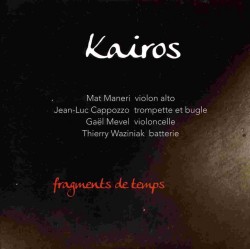 Enlarging a band and its affiliated timbres even more is the Kairos quartet (Label Rives 7 labelrives.com). On Fragments de temps the basic duo of French cellist Gaël Mevel and drummer Thierry Waziniak is joined by fellow Gaul trumpeter/flugelhornist Jean-Luc Cappozzo and American violist Matt Maneri. The result is inventive and invigorating improvised chamber-jazz. With nods towards classic traditions some tunes are contrafacts of Ravel or Rodgers & Hart lines, while at the disc’s centre are two affiliated pieces called Bach 1 and Bach 2. Slyly beginning the first with a delicate meld of flugelhorn flutters and well-tempered string smoothness, drum clips and low-pitched cello slides soon chip away at the pseudo-Baroque delicacy. Half-valve and toneless brass explorations, double bass-like throbs from Mevel and Maneri’s mandolin-like strums create a polyphonic lamination that is resolved on Bach 2. Sustained sharp strokes from the cello (andante) and the viola (adagio) coupled with irregular drum smacks maintain the exposition as bass bites and Maneri’s staccato jabs transform the narrative. With themes expressed by motifs including cello-trumpet harmonies or viola-cello refractions, the quartet additionally maintains horizontal expressions even as pivots and note bending fragment the time.
Enlarging a band and its affiliated timbres even more is the Kairos quartet (Label Rives 7 labelrives.com). On Fragments de temps the basic duo of French cellist Gaël Mevel and drummer Thierry Waziniak is joined by fellow Gaul trumpeter/flugelhornist Jean-Luc Cappozzo and American violist Matt Maneri. The result is inventive and invigorating improvised chamber-jazz. With nods towards classic traditions some tunes are contrafacts of Ravel or Rodgers & Hart lines, while at the disc’s centre are two affiliated pieces called Bach 1 and Bach 2. Slyly beginning the first with a delicate meld of flugelhorn flutters and well-tempered string smoothness, drum clips and low-pitched cello slides soon chip away at the pseudo-Baroque delicacy. Half-valve and toneless brass explorations, double bass-like throbs from Mevel and Maneri’s mandolin-like strums create a polyphonic lamination that is resolved on Bach 2. Sustained sharp strokes from the cello (andante) and the viola (adagio) coupled with irregular drum smacks maintain the exposition as bass bites and Maneri’s staccato jabs transform the narrative. With themes expressed by motifs including cello-trumpet harmonies or viola-cello refractions, the quartet additionally maintains horizontal expressions even as pivots and note bending fragment the time.
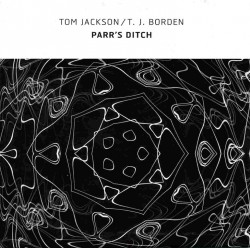 Although much of the cello’s appeal over the centuries has been melodic tones that can be created with its four strings, the instrument’s percussive and discordant qualities can also be featured. More so than on the other discs this happens on Parr’s Ditch (Confront CORE 41 confrontrecordings.bandcamp.com/album/parrs-ditch). Brooklyn-based cellist T.J. Borden highlights many of these barbed timbres in this duo with clarinetist Tom Jackson of London, England. Heard during three lengthy improvisations are a few linear and lyrical interludes. But the key idea of the duo is to express as wide a variety of rugged and pointed strokes with a bow, fingers and a minimal number of strings as the clarinetist can produce with his reed and multiple keys. While Jackson’s collection of altissimo squeaks, watery trills and intensified breaths set up the challenge from the first sequences, Borden’s exposition of sul ponticello stabs and strident string whistles match tones with similar aggression. Often these spiccato slices also cut through the clarinetist’s clarion calls. By the time Parr’s Ditch 2 arrives, stop-and-start reed elevation is supplemented by equally belligerent arco timbres which are sourced from below-the-bridge strings and often sound as if they’re lacerating the wood itself. Additionally, as Borden’s col legno stops and Jackson’s flutters intertwine they reach such prestissimo affiliations that if the program was visual the result would be a blur. Later the clarinet’s transverse slobber and the cello’s harsh flanges almost meld. Until more generalized reed puffs and descending string vibration mark a final concordance, strained ruggedness has defined the interaction.
Although much of the cello’s appeal over the centuries has been melodic tones that can be created with its four strings, the instrument’s percussive and discordant qualities can also be featured. More so than on the other discs this happens on Parr’s Ditch (Confront CORE 41 confrontrecordings.bandcamp.com/album/parrs-ditch). Brooklyn-based cellist T.J. Borden highlights many of these barbed timbres in this duo with clarinetist Tom Jackson of London, England. Heard during three lengthy improvisations are a few linear and lyrical interludes. But the key idea of the duo is to express as wide a variety of rugged and pointed strokes with a bow, fingers and a minimal number of strings as the clarinetist can produce with his reed and multiple keys. While Jackson’s collection of altissimo squeaks, watery trills and intensified breaths set up the challenge from the first sequences, Borden’s exposition of sul ponticello stabs and strident string whistles match tones with similar aggression. Often these spiccato slices also cut through the clarinetist’s clarion calls. By the time Parr’s Ditch 2 arrives, stop-and-start reed elevation is supplemented by equally belligerent arco timbres which are sourced from below-the-bridge strings and often sound as if they’re lacerating the wood itself. Additionally, as Borden’s col legno stops and Jackson’s flutters intertwine they reach such prestissimo affiliations that if the program was visual the result would be a blur. Later the clarinet’s transverse slobber and the cello’s harsh flanges almost meld. Until more generalized reed puffs and descending string vibration mark a final concordance, strained ruggedness has defined the interaction.
The crafts people who evolved the cello from the viola de gamba and bass violin centuries ago to become the instrument it is today, likely couldn’t imagine the multiple roles exemplified by the sounds on these discs. But we can hear them.
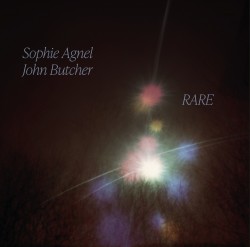 Rare
Rare

